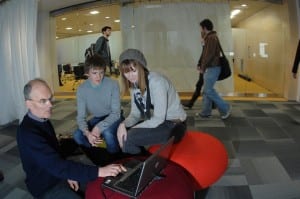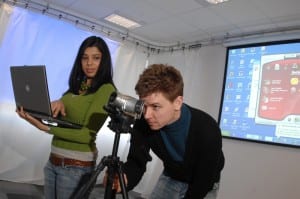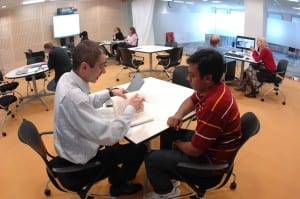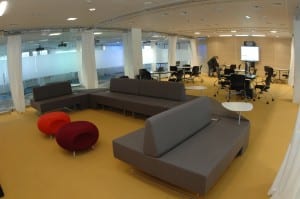University of Warwick: The Teaching Grid
Innovation

Students at work
The focus of the case study at the University of Warwick is the Teaching Grid, which forms part of the library’s service provision, and is located on the second floor of the library building in the centre of the university’s main campus. The Teaching Grid builds on the success of an earlier project by the library, the Learning Grid, which is an extremely successful learning resource centre for students, which the students ‘own’ and manage.
The Learning Grid, has become a model for social learning spaces that are now commonplace on university campuses. ‘Key to the success of the Learning Grid is not simply the flexibility, the technology and the opening hours, but the fact that students are engaged in the running and management of the space, creating a very real sense of student-centredness and ownership of the space by the students’ ( Senior Manager).
While the Learning Grid is designed to facilitate and support student learning, the Teaching Grid is for the use of academics who wish to experiment with new and innovative ways of teaching and learning ‘…we wanted to provide a space where academics could try out new teaching methods…so this space is really for academics…students are not invited in here unless they are part of the teaching set up’ (Architect).
To support innovative approaches to teaching and learning, the Teaching Grid is equipped with high specification technology such as interactive white boards, visualisers and multi-media equipment. The Teaching Grid feels like a performance space with large open areas and curtains that can change the dynamics of the room and can be used to project images onto. The space has moveable partitions and is designed to be more informal than a traditional classroom. Moreover, the Teaching Grid acts a social area for members of staff to meet and discuss teaching and learning and share good practice.
All this is supported by the Teaching Grid’s website ( HYPERLINK “http://www2.warwick.ac.uk/services/library/teachinggrid/” http://www2.warwick.ac.uk/services/library/teachinggrid/) that encourages dialogue between members of academic staff with reports and records of the developmental teaching practices that have gone on in the space.
Perhaps the most important element of the Teaching Grid is its ‘service model’ which is provided by the manager of the Teaching Grid and a small group of support staff ‘…as well as developing the space you also need to develop the service model… we did not just open the doors and hope for the best’ (Support Staff).
The Teaching Grid’s ‘service model’ provides academics with support and guidance throughout all stages of the delivery of a proposed lesson, including its preparation, delivery, and evaluation ‘…the support element is increasingly important because there are a variety of different technologies and approaches to teaching and learning out there. The support mechanisms enable staff to feel comfortable with these new technologies and therefore more prepared to give them a try’ (Support Staff). The manager of the Teaching Grid is a qualified teacher and plays a key role in providing a support model that encourages trust and offers solutions to the academic staff.
Although it is early days for the Teaching Grid, (it opened in March 2008) it appears to be working well. What will be interesting about assessing the success of this space will be to what extent academics will be able to deliver similar innovative lessons in classrooms that do not share the same level of personal and technical support as the Teaching Grid ‘…there aren’t a lot of other spaces in the university like the Teaching Grid and I think there is a danger for us that we are raising expectations’ (Support Staff). However, the Teaching Grid sees itself as part of a wider programme of change at Warwick that is working towards an improvement in teaching and learning spaces across the campus.
Other such spaces include the Reinvention Centre on the Westwood site, which is designed to support collaborative teaching and learning between students and teachers by designing research and research-like activities into the undergraduate curriculum.
Vision and Mission

Media work
Established in 1965 Warwick has rapidly become one of the top universities in the country. Situated on a green-field site on the outskirts of Coventry, Warwick has been voted by students as the best university campus in the UK. The university is expanding its global connections with aspirations to be in the top 50 of world universities by 2015.
The university aims to achieve this through enhancing its international reputation by carrying out the very best research and teaching, by attracting the highest quality staff and students, and by working with relevant stakeholders, including business and industry, government and government services, donors and alumni.
Warwick is keenly aware of the spatial dimensions to this ambition. This is reflected in its awareness of the significance of its geographical location and the importance of the campus’s learning landscape. In terms of the former, the university aims to be positioned as an intellectual gateway to the UK and beyond through its regional, national and international engagements; and with regard to the latter, the ambition is to make the Warwick campus into a representation of the strength of its ambitions and the quality of its imagination, including the highest standards of design for its teaching and learning spaces.
The radical instinct that informs the university vision for its future is captured by a senior manager:
‘At Warwick the issue is how to take the radical step, what are the catalysts needed for change and, within the context of one’s own institution, how is it possible to think outside of the box.’
Leadership and Governance

Study space
The university has a hierarchical organisational structure, with a central decision making body with faculties and chairs of faculty having very little decision making power outside of the formal structure. Thus, the heads of departments and faculties act more like a ‘conduit’ for information, between the faculties and the core decision making process of the university ‘…faculties are not particularly powerful, with faculty chairs acting as a go – between, or facilitator between the university and the departments’ (Senior Academic). The university’s committee structure is set up to encourage a horizontal flow of information so that all departments and faculties are aware of what is happening at the university by having overlapping membership to ensure dialogue between them. However, the university’s organisational structure has led to concerns being raised by some members of staff, especially with regards to the design of teaching and learning space, with a general feeling that it limits innovation ‘I do not believe that the Warwick decision making process would have created something like the Reinvention Centre’ (Support Staff).
This is something that the university is trying to address, and as such has attempted to enhance its decision making processes ‘we have worked quite hard on getting the governing body to be much more effective over the past few years…we now have a very effective council and they recognise that teaching along with research are priorities’ (Senior Academic). In addition to this, there has been an attempt to move towards a more diffused leadership model, so that the core decision making body can focus on making larger scale decisions ‘there has been motion to push quite a lot of the decision making outwards and downwards’ (Senior Academic).
The university actively seeks to involve students in its decision making processes: ‘…Warwick is good at involving students in all levels of decision making and the president of the Student Union is expected to contribute to strategic discussions. Two members of the Student Union sit on the university Senate and university council so they are involved in the highest levels of decision making. The students get full access to the decision making process and their voices are listened to’ (Senior Academic).
In addition, students are also involved specifically in space planning, and the Teaching Grid has hosted a competition for students to design teaching and learning spaces. It is interesting to note that the students are usually not particularly interested in space planning and often do not share the academics passions for spatial innovation ‘…the sabbatical officer for education was the most conservative one on the user group for the Teaching Grid’ (Senior Manager).
Developing the Brief

Varied spaces
The idea for the Teaching Grid came from the success of the Learning Grid, and specifically from members of academic staff who thought they needed a place of their own to develop teaching and learning at the university. Thus, the idea was to provide academics with a space where they could conduct and be supported in planning and carrying out developmental teaching and learning projects ‘…we wanted to provide a flexible space, where the users can create their own environment’ (Architect). The funding for the Teaching Grid was part of a wider funding bid to refurbish a substantial part of the main library.
There were some problems with the development of the original brief, which was thought to be too mainstream and standard, so was changed to provide something that would be much more innovative ‘…the original brief did not quite work…and in the end the library team said we are not being innovative enough in our approach’ (Architect). One reason for the lack of initial innovation was that the project had to be developed over a short period of time ‘…the trouble was with the way briefing process worked, it did not encourage people to get together for long enough to actually allow for a cross fertilisation of ideas to a happen’ (Architect). There was a feeling amongst some members of the user group that this truncated nature of the briefing process had a negative impact on the original design of the space ‘…you should be very careful about stopping the discussions too soon when developing the brief, however the estates department will give you a very different perspective because they will quite rightly say that a lengthy briefing process increases cost’ (Senior Manager).
Other problems with the consultation process include the fact that an over extensive process can tend towards a dilution of the original aims of the project through a search for consensus: ‘you start out with the ambition to be visionary and innovative, but because of the large size of project working groups the end product bears little relationship to what they set out to do originally, and there is a tendency to all go back to the comfort zone of how do we make sure we get bums on seats’ (Senior Manager).
One of the most important aspects of ensuring the project achieved its aims in terms of innovation was the relationship between the architects and the user group. This relationship had been built up by working together on a number of previous projects ‘…we had forged a good relationship with the architect because he had worked on the Learning Grid with us’ (Support Staff). As such, the architect was very engaged with the development for the brief from an early stage, providing the user group with ideas for the space.
As a result of this experience, Senior Managers at Warwick are very clear about what constitutes an effective project design process at Warwick and elsewhere:
‘HEIs need to provide a programme of formal planning that supports strategic experimentation. This programme needs to be based on a free flowing process, as well as projects that are derived out of more central planning protocols. It may be that conventional committee structures and management procedures are not helpful in designing innovation into our teaching and learning spaces. Service departments, and particularly the Library and other learning resource providers, can act as catalysts within institutions’ ( Senior Manager).
Project Management
The university does not have a formalistic approach to corporate project management, but uses a system based on experience, grounded in the relevant theory. This was identified by members of the user group as being significant in the development of the Teaching Grid, allowing flexibility and an ‘evolutionary dialogue’ to unfold between the user group and the architect ‘…one brilliant thing about Warwick is that they have never imposed a project structure on us. I could lead the project with the architect from a philosophical point of view’ (Senior Manager).
Post Project Evaluation
The Teaching Grid has undergone informal post project evaluation, which has included talking to academics and students after they have used the space. Interestingly, some of the respondents did acknowledge that there are limitations to what formal post project evaluation can demonstrate, such as the impact of space on student grades ‘…I find this evaluation stuff really hard, I mean you can get the sort of qualitative feedback from both teaching staff and students but the really big thing is to know the outcomes in terms of student grades’ (Senior Manager). Another important aspect of evaluation is how you assess the space in terms of the learning experience it provides for teachers ‘…the added value is invisible really… it can’t be monitored in terms of money, and can’t be costed as such’ (Architect).
Leave a Reply